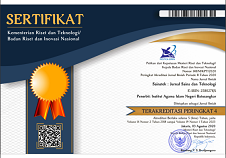EXPLORASI DAN MUTU BERAS GENOTIP PADI MERAH DI KABUPATEN PASAMAN BARAT SUMATERA BARAT
Abstract
The purpose of this study was to determine the nutrient content based on the phenotype of red rice in West Sumatra West Pasaman. The study was conducted in the West Pasaman by doing a survey to determine and collect the red rice in the area. Limited access to isolated areas growing regions in the rice collection was also done by buying rice from the traditional market vendors West Pasaman. Analysis of the nutrient content in the form of protein and amylose conducted in the Laboratory of Chemistry Department of Chemistry, State University of Padang. The results showed that in the West Pasaman found 5 red paddy rice genotypes. Amylose content ranged from 27.16% to 40.13% Island Manggis until at Nabara. Protein content ranged from 5.93% to 8.72 on the genotype Nabara Cimarisik genotype. Based on these results it can be concluded that the Dolok Nabara (8.25%) and Cimarisik (8.72%) developed considering the potential for relatively higher protein content than rice genotypes grown in West Sumatra. In conclusion, the amylose content of the five genotypes were high.
Key words: explorasi, genotip, quality rice, red rice, west pasaman
Full Text:
PDF (Bahasa Indonesia)References
Anhar A, Doni F dan Advinda L. 2011. Respon pertumbuhan padi (Oryza sativa) terhadap introduksi pseudomonad flou-resence. Eksakta Vol. XII No. 1.
Anhar A dan Leilani I. 2001. Kelestarian plasma nutfah padi lokal pasca program intensifikasi pertanian (studi kasus di Kabupaten Solok). Sainstek Vol III (2):129-138.
AOAC. 1970. Official Method and Analysis of The Association on The Official Analy-tical Chemists 11th Edition. Washington D.C.
Aryana IGM. 2009. Adaptasi dan stabilitas hasil galur-galur padi beras merah pada tiga lingkungan tumbuh. J. Agron. Indo-nesia 37 (2): 95 – 100.
Budiyanto A, Widowati S dan Santosa BAS. 2008. Sifat amilografi beras berkadar amilosa sedang dan prospek peman-faatannya untuk industri pangan. Prosi-ding Seminar Nasional Padi :1535-1547.
Fitriani V. 2006. Beras merah bukan kenyang tapi sehat. Dalam http://www. Tru-bus.co.id.
Indrasari SD. 2006. Padi aek sibundong: pangan fungsional. Penelitian dan Pe-ngembangan Pertanian Vol.28 (6) :1-3.
Juliano BO. 1971. A simplified assay for milled rice amylose. Cereal Sci. Today 16:334-340 Dalam http://www.fao. org inpho/vlibrary /t0567e /T0567E0 a.html. (Diakses 7 November 2004).
Muliarta IGP, Sudantha IM dan Santoso BB. 2012. Daya hasil dan penampilan feno-tifik karakter kuantitatif galur-galur padi gogo beras merah. Prosiding Insinas 2012.
Rifai, M. 1987. Apa yang perlu anda ketahui tentang plasma nutfah. Diskusi panel 3 hari plasma nutfah. Kerjasama Walhi-Kelompok 10-Trubus. Jakarta 12-14 Februari.
Silitonga TS. 2008. Konservasi dan pengem-bangan sumberdaya genetik padi untuk kesejahteraan petani. Makalah. Pekan Budaya Padi 2008. KRKP
Siwi BH dan Kartowinoto S. 1990. Plasma Nutfah Padi. Padi Buku II. Bogor: Pusat Penelitian dan Pengembangan Tanaman Pangan.
Suardi D. 2005. Padi beras merah: pangan gizi yang terabaikan?. Warta Penelitian dan Pengambangan Pertanian Vol 27 No.4.
Swasti E dan Putri NE.2011. Pengembangan padi merah dalam rangka meningkatkan kesejahteraan petani. J. Embrio 4 (2): 90-98.
Wang XQ, Qing YL, Zhi SG, Li X and Quan LQ. 2010. Determination of amylose content and its relationship with rva profile within genetically similar cultivars of rice (Oryza Sativa L. sp. Japonica). Agricultural Sciences In China 9(8): 1101-1107.
DOI: http://dx.doi.org/10.31958/js.v5i1.76
Refbacks
- There are currently no refbacks.
Copyright (c) 2016 Azwir Anhar

This work is licensed under a Creative Commons Attribution-NonCommercial-NoDerivatives 4.0 International License.
Indexed by:
__________________________________________________________________________
Sainstek: Jurnal Sains dan Teknologi
ISSN 2085-8019 (print) | 2580-278x (online)
Published by Institut Agama Islam Negeri Batusangkar
Email: sainstek@iainbatusangkar.ac.id
This work is licensed under a Creative Commons Attribution-NonCommercial-NoDerivatives 4.0 International License.















